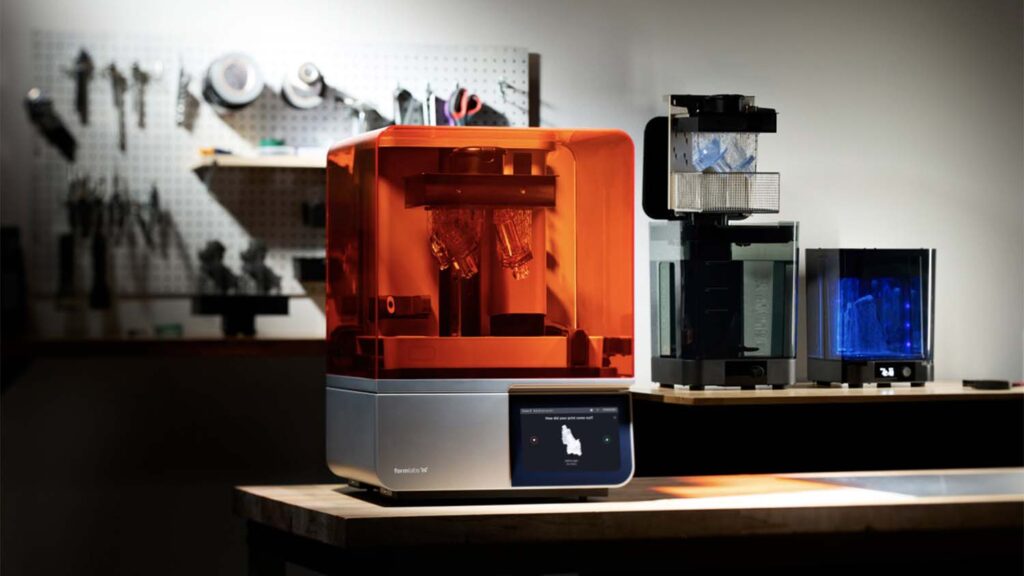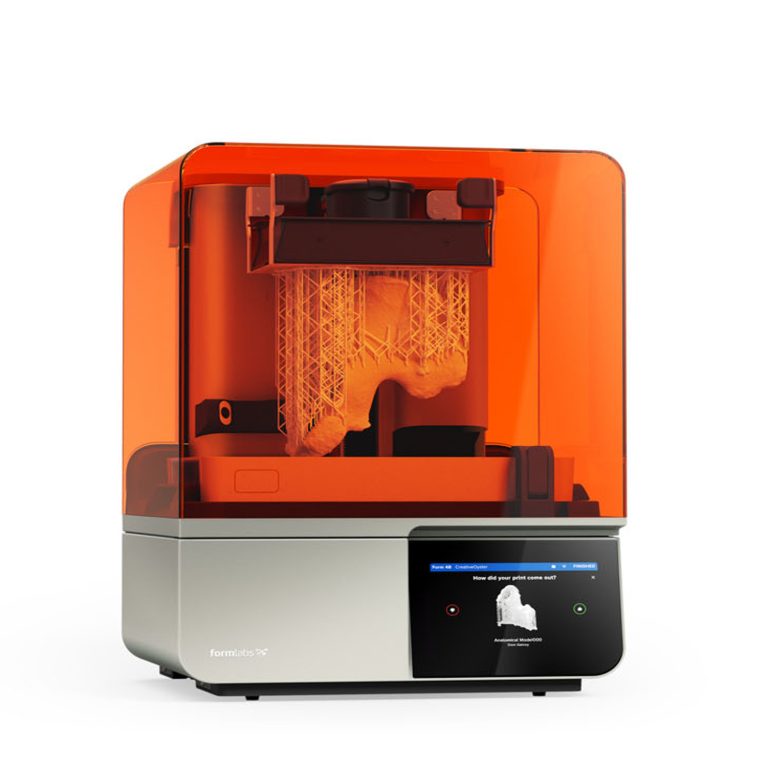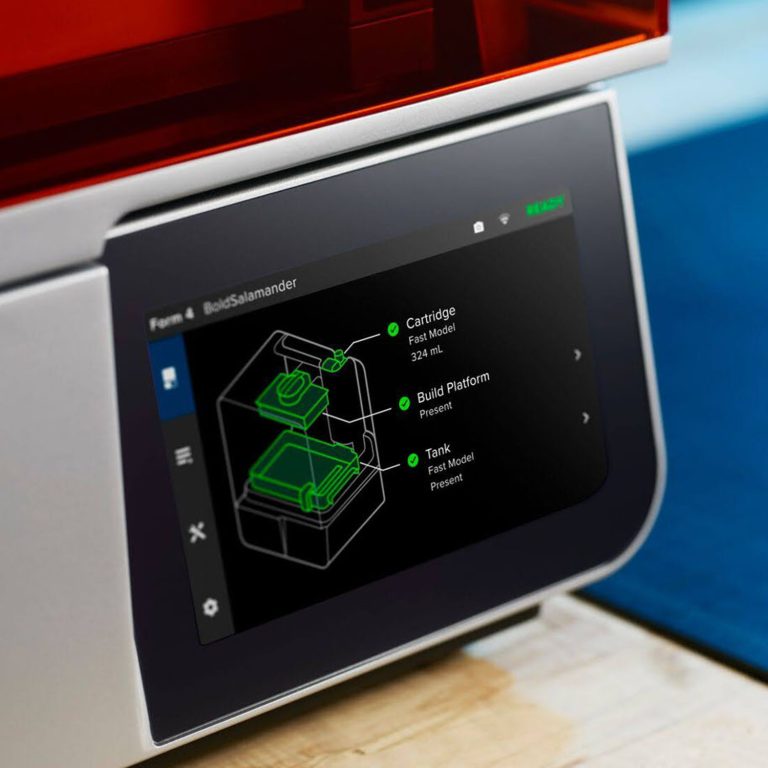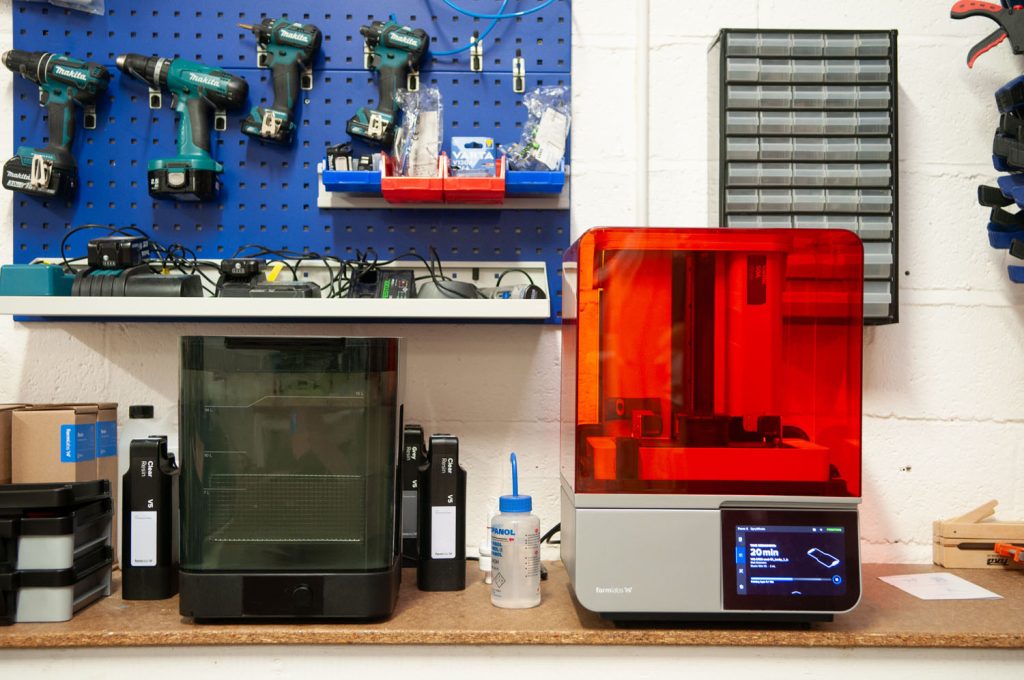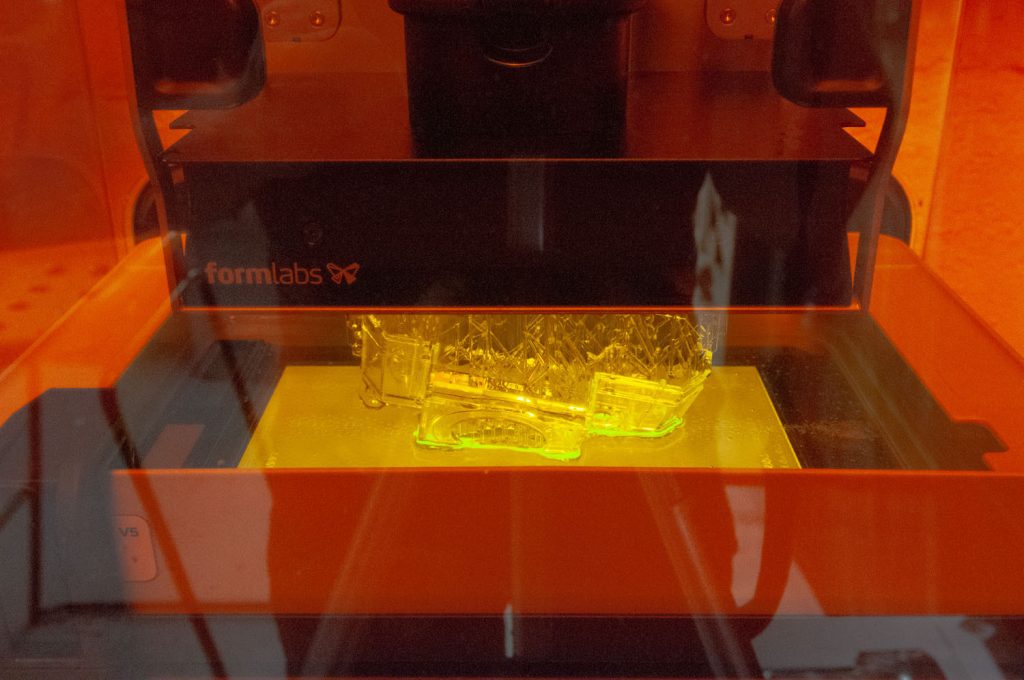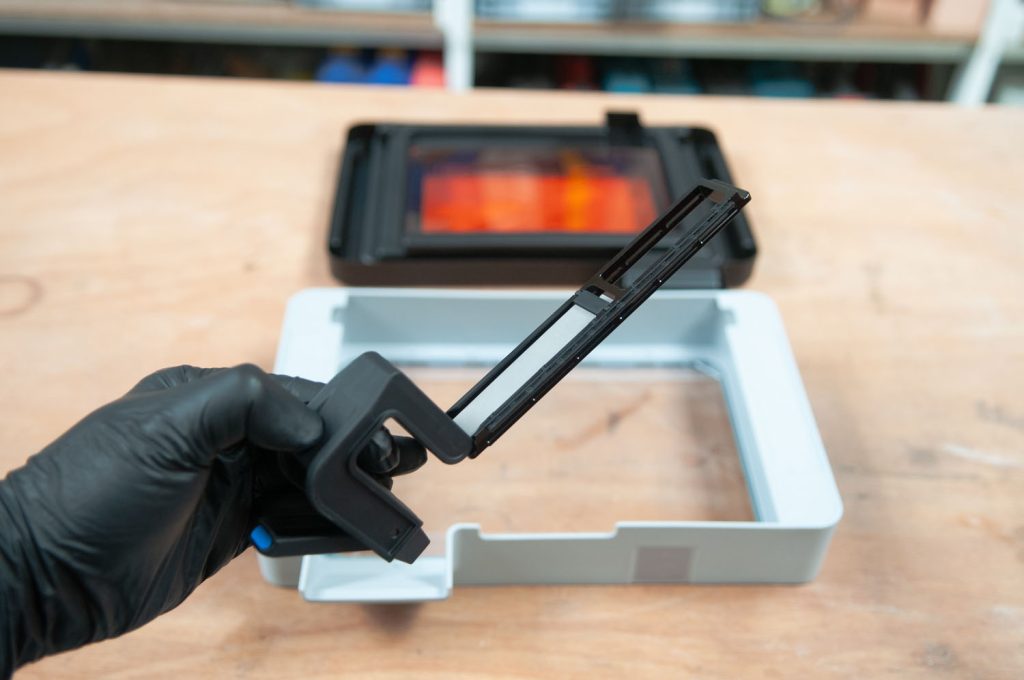The Form 4 is billed as Formlabs’ fastest 3D printer yet, but that’s not just down to its new, lighter engine. Matt Batchelor puts the machine through its paces and finds that every aspect of its design shaves off time and makes set-up a breeze
Since 2011, inverted stereolithography (SLA) pioneer Formlabs has grown from a Kickstarter-funded spin-out from MIT Media Labs to an established manufacturer of smallerscale, low-cost SLA machines, with over 100,000 products out in the field.
Its new Form 4 SLA 3D printer marks a transition from using a scanned laser beam to cure resin layers to a projected light source, a shift that Formlabs executives claim contributes to the 3D printer being between two and four times faster than the Form 3. That’s primarily because each layer is exposed in one go, rather than being scanned line by line.
The new machine is also claimed to warm the resin up to operating temperature more quickly and to perform pre-print calibration faster, too. New resins optimised for the printer are said to further accelerate the user’s workflow.
With a brand-new Form 4 3D printer and v2 Form Wash station installed in the workshop at Instrument Product Development in South-East London for long term testing, it was time to check out these claims and to gauge the advancements achieved with the Form 4, especially when compared to the Form 3 sat on the workbench nearby.
Form 4 // First impressions
The machine arrives well-packaged in several boxes. In addition to the printer, Formlabs sent us three resin trays, three mixer arms (now a separate SKU), a Form Wash v2 and three litres of grey and clear v5 resin and Elastic 50 Shore Resin.
With no transit screws to mess with, it’s simple to pull the product out of the box, power it on and run the built-in levelling routine, which uses an on-screen ‘spirit bubble’ and a handy wrench disc to turn the four threaded feet.
There is now a metal frame around the base of the acrylic hood to provide stiffness and the optics are sealed behind a glass panel with a 3D ‘wave’ surface that Formlabs calls a Release Texture.
While the Form 3 performs some kind of electromechanical movement in order to detach a freshly built layer from the film of the resin tray, the Form 4 just lifts the build platform. This texture must help break the suction somehow.
A fine resolution (50 microns per pixel) LCD mask sits under the panel, while a beefy mechanical drive for the new mixing arm runs in a track under the splash guard. By contrast, the Form 3 has a vulnerable open space where the scanning optics transit.
A physical power switch now lets you power down the machine to save energy while it is not in use, which is a nice addition.
Formlabs now offers polyurethane and silicone rubber resins (although these were not tested). To accommodate these more hazardous chemistries, there is now a fume extraction port at the back. This is sealed by a 3D-printed plug, built on a Form 3 in Tough 1500 resin, according to the embossed text.
Additional 3D-printed elements on the new machine include a small tool caddy printed on a Fuse 1, which clips in the top of the frame. The resin tanks are now clamped in place by two large over-centre latches on each side.
The resin cartridges are now a different shape – more square in cross-section than Form 2 and 3 cartridges. This is supposedly to save material and support improved thermal efficiency, although it comes at the expense of backwards compatibility.
The resin is still dosed out by a ‘burp’ valve, but the valve on the newgeneration tanks is much bigger. We have not experienced any issues with the valve clogging on the Form 4, which we did see with several resins used in the Form 3 and the older cartridge.
Filling happens so fast that it took us a few prints to figure out when it actually happens – right at the start of the process, semi-obviously.
The resin trays themselves no longer have a full protective box for storage. The actual tray is now a more rigid component, and the new base film seems harder – identical to a mylar drum head. Unlike lower cost machines, this film is not user replaceable, as the metal carrier frame that tensions the film is heat-staked into the resin tray frame.
As far as I can tell, there are no life restrictions on the tray with certain resins, so maybe it will prove durable enough to not need replacing, whereas we did have to retire a couple of Form 3 trays where the softer film had delaminated.
A thermoformed lid is provided, which keeps light and dust out of your precious resin when not in use and facilitates a stable stack of trays.
One important detail to note is that the mixing arm is now a separate purchase from the tray. Formlabs say that this is to avoid unnecessarily having to replace both when one wears out. You could clean and reuse the arm between several resins, but it would be a pain and Formlabs doesn’t recommend it.
The new tray and arm together cost £99 plus VAT (£20 + £79) whereas the Form 3 tank including a mixer is £120 plus VAT, so at least they have not used the two SKUs as an excuse to bump the price.
(Though it’s worth noting that this is an improved version of the Form 2 design, which is just £50 all-in.)
Finally, the build platform is more rectangular, at 200 x 125 mm versus 145 mm square on the Form 2 and 3, and offers a maximum build height of 210 mm (versus 193 mm).
Formlabs claims an average print speed for the Form 4 of 40 mm of height per hour, versus 11 mm/h with the previous generation.
Our Form 4 was provided with the ‘Flex’ build platform with a flexible stainlesssteel sheet to help peel models off. This costs £110 more than the standard rigid aluminium plate (£209 versus £99), but enables much easier part removal and the possibility of printing directly onto the build plate.
The same flexible set-up is also available in the old Form 2/3 form factor.
Pleasingly, for anyone with previous Formlabs machines, the new Form Wash – a large tank of solvent with an agitating rotor in the base and a lift mechanism that holds the build platform and print with a mesh basket for loose components – is backwards-compatible with the Form 2 and 3 build platforms, with support arms that can be relocated to suit the differently sized baseplate.
The Cure UV oven, meanwhile, remains the same.
Form 4 // Pre-processing parameters
As with its other printers, Formlabs’ proprietary (but free-to-download) software Preform is used to set up a print job with the requisite support structures and resin curing parameters.
Mesh files in .stl, .obj and .3mf files are supported and jobs can be saved as .form files.
No neutral ‘analytic’ formats – such as .step or .iges – are supported, requiring some form of import and conversion to mesh in order to work.
Formlabs’ pitch is that everything works appliance-style using built-in validated presets. As a result, the interface is very geared towards clicking auto-generate and then uploading via a local network (WiFi or good ‘ol Ethernet), or over the web if you have enabled remote printing on your printer.
Preform is pretty good at the automatic flow, with warnings of possible print errors, but it would still be good to be afforded more manual control, since the support structure algorithm often puts support points on functional or hard-topost- finish feature edges.
There is a ‘brush’ tool to scatter points in a somewhat controlled fashion, but the ability to axially pattern a manually generated layout would be a huge time-saver. There is an option for an ‘Open Material’ mode with more settings (this starts at £1,699 plus VAT), but presumably this intended either for bureaux that use so much resin that they want to use a thirdparty material with their own settings, or researchers building their own materials. It certainly isn’t a money-saving option for more moderate users, and if you need it, then you probably know more about materials and their uses than us.
Time to print
First impressions of the Form 4’s print performance are dominated by how fast it runs. Because of the layer-by-layer process, there is no time penalty for filling the bed, and you can almost watch the build platform ease its way out of the resin bath. If you are printing in a clear resin, you can see the cross-sections being exposed through the UV filtering orange cover.
We did have some issues with autogenerated supports becoming detached in the clear resin, but we fixed the issue by adding a few more support points.
Like many SLA printers – or any manufacturing process involving a phase change – we did see some warping on more complex parts, but were mostly able to fix this by printing in a completely vertical orientation. The prints were crisp and accurate, in line with Formlabs’ suggested tolerances, to the point where some small (#10-32 UNF) threads just needed a tidy-up with a plug tap.
There is even a camera built in for checking on prints remotely, which is easily turned off during set-up if your security policies require it. This is accessed via Formlabs’ online dashboard.
The camera can take a time-lapse sequence of parts emerging from the resin, but doing so slows the print down, as it requires the printer to hold still for each frame. We did it once for the Terminator reference and then turned it off.
Wash and cure
The new Form Wash (£579 plus VAT) moves solvent noticeably more vigorously than the previous model. With the resins we tested, wash times were down from 20-40 minutes to 5-10 minutes and with less ‘snot’ to wash off manually when using the new v5 resins.
Using our Form 3, we would normally take the worst off in a tub of IPA before putting a print in the original Form Wash. Even then, we sometimes need to take the parts off of the build platform and perform another wash in the ‘chip basket’ to get the last of the primordial goo out from around the supports.
This improved washing workflow is a massive time-saver. It also becomes backwards-compatible with the Form 3 build platform by moving the supports inwards, and is able to run only part-filled with solvent for those who never use the full height of the printer’s build envelope. That potentially saves on solvent usage, which is a nice bonus. There is now a seal under the lid, but it did not seem to ease the rate of evaporation of the alcohol.
Our printer came with the ‘Flex’ build platform (£209 plus VAT). I liked it, having spent too much time levering prints off the original rigid platforms on our Form 3.
A flexible stainless steel sheet is fixed to two steel brackets that form a magnetic pivot with two grooves in the build platform. When a print is washed and ready to cure, you squeeze the pads on the top of the brackets together, flexing the sheet and releasing the print. This is much more elegant than trying to pry a print off the more basic aluminium blocks still available for £99 plus VAT.
The Form Cure oven, meanwhile, has not been replaced. The new v5 resins can be cured at room temperature and for shorter periods than v4 equivalents – five minutes for Grey v5, versus 30 minutes at 60C for Grey v4.
We have sometimes gone off-menu and cured our parts at room temperature to avoid warping issues on certain parts, but it’s nice to be working closer to the ‘official’ recommendation. It also saves more time as the curing unit does not have to warm up to temperature.
Conclusion
It would be fair to say we expected more of an incremental improvement over the previous Form 3, but the faster cycle time of the Formlabs Form 4 has genuinely changed how we use it.
The time investment demanded by a Form 3 print means that some bigger jobs present an overnight or even over-theweekend challenge, with a few hours needed afterwards for post-processing. The Form 4, by contrast, is fast enough to turn around some simple parts in a couple of hours or to perform multiple runs in a day for more complex jobs.
In real terms, this marks a change from the Form 4 being a high-resolution ‘verification’ machine to something that can be used for process models to help figure out details during a design process.
For existing Form 3 owners, the backwards compatibility – or lack thereof – will complicate the decision to upgrade, as they will likely have several hundred pounds already invested in resins and print trays and may be reluctant to buy a new washing device.
In fairness, Formlabs has kept a decent level of commonality between the Form 2 and Form 3, which together represent some 10 years’ worth of development. Plus, the new changes do make sense, unless your work absolutely requires the squarer proportions of the older build envelope.
All moving parts on the Form 4 (and the Fuse 1) are now field replaceable units, with spare parts available for purchase from Formlabs. This is a huge boon, enabling businesses to keep assets in use for as long as they work.
The Formlabs team does not provide definitive end-of-life dates for the Form 3, 3L, 4 or Fuse, but at time of publishing, parts for the Form 2 (launched in 2015) are still available, even if it is no longer ‘officially’ supported on a service plan.
The Form 4 is a really good machine, built with the needs of professional users clearly in mind. The big selling point of increased speed aside, it manages to make the SLA 3D printing slick and straightforward, allowing users to better use time previously spent messing around on set-up and post-processing tasks.
Specifications
» Formlabs Form 4 From £4,439 (Ex VAT)
» Build Volume (W x D x H) – 20 x 12.5 x 21cm
» Layer Thickness (Z resolution) – 25 – 300 microns
» XY Resolution – 50 Microns
» Maximum Print Speed – 100mm/h
» Printer weight – 18.3kg
» Printer dimensions – 39.8 x 36.7 x 55.4cm
www.formlabs.com
This article first appeared in DEVELOP3D Magazine
DEVELOP3D is a publication dedicated to product design + development, from concept to manufacture and the technologies behind it all.
To receive the physical publication or digital issue free, as well as exclusive news and offers, subscribe to DEVELOP3D Magazine here

